MORE BIODIVERSITY IN URBAN AREAS – Biodiversity enhancements in our own gardens
You have to re-green mindscapes, to re-green landscapes (Tony Rinaudo, Right Livelihood Preisträger, 2018)
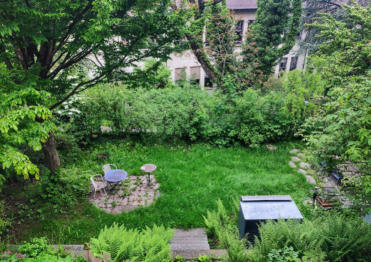 The garden
The garden
4 Biodiversity enhancements
4.1 More native shrubs
During the summer months, the wild shrubs and trees provided privacy from the park and concealed the wire mesh fence. During the winter months, they were cut back once a year from the lawn. In order to give the area to be upgraded more diversity and biodiversity, all shrubs and trees growing along the fence were removed, including their roots. The wood was added to existing small structures, which already contributed to promoting biodiversity. During removal and replanting, the undergrowth was largely preserved, as it provides an important habitat for many insects, birds and small animals. However, invasive species such as ivy and blackberries were specifically reduced or completely removed to make room for the newly planted shrubs.
Small and medium-sized native shrubs were then planted on the newly created open space (2/4m x 10m) in accordance with the ecological principles of a valuable wild hedge. Of these, 30% of the new shrubs have thorns or spines to provide birds in the area with better protection from the numerous domestic cats in the area, as well as places of refuge and nesting sites. Most of the shrubs planted bear abundant flowers and fruits, which provide valuable food sources for numerous animal species. When planting, larger shrubs were strategically placed close to the fence, while smaller specimens were positioned closer to the lawn.
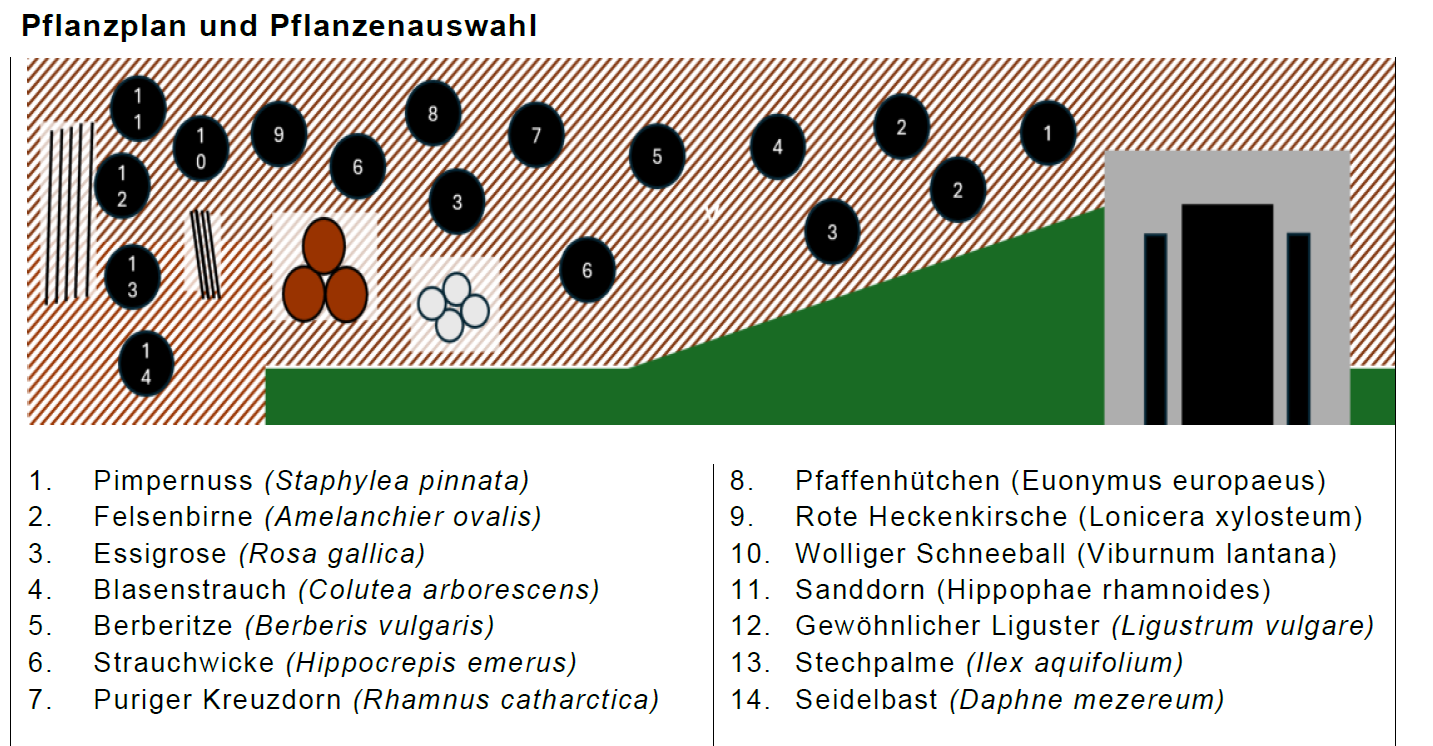 Tab 4 - Planting plan and plant selection
Tab 4 - Planting plan and plant selection
| 1. European Bladdernut (Staphylea pinnata) | 8. Spindle tree (Euonymus europaeus) |
|---|---|
| 2. European Serviceberry (Amelanchier ovalis) | 9. Fly honeysuckle (Lonicera xylosteum) |
| 3. Gallic Rose (Rosa gallica) | 10. Wayfaring tree (Viburnum lantana) |
| 4. Bladder senna (Colutea arborescens) | 11. Sea buckthorn (Hippophae rhamnoides) |
| 5. Barberry (Berberis vulgaris) | 12. Common privet (Ligustrum vulgare) |
| 6. Yellow rockrose (Hippocrepis emerus) | 13. Holly (Ilex aquifolium) |
| 7. Purige buckthorn (Rhamnus catharctica) | 14. Daphne (Daphne mezereum) |
In detail, this meant that the sycamore maples and silky dogwoods lining the fence were removed to ensure that no unwanted propagation or uncontrolled growth could take place. The decision to remove all plants, including their roots, was aimed at preventing future problems and making room for planned replanting.
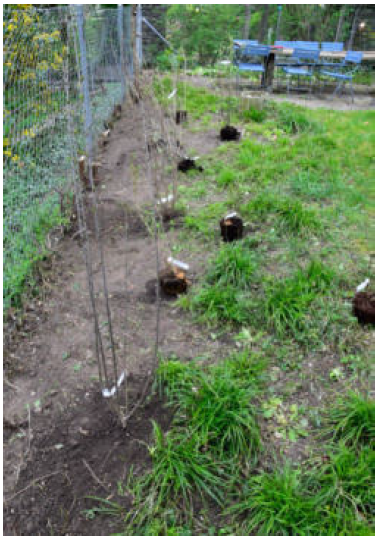 Pic 7 - Layout for planting shrubs
Pic 7 - Layout for planting shrubs
Particular emphasis was placed on preserving the existing undergrowth. This undergrowth not only provides shelter and food for numerous animal species, but also contributes to soil stabilisation and water regulation. The measures included the targeted reduction or complete removal of invasive species that could overgrow other plants. The removal of ivy and blackberries ensured that the new shrubs would find optimal growing conditions and be able to establish themselves well.
The new planting area along the fence was designed according to ecological principles and with consideration for local biodiversity. This not only improved the aesthetic quality of the park, but also contributed to species protection. Native shrubs were selected that not only offer aesthetic advantages, but are also ecologically valuable. The arrangement of the shrubs was strategic: larger specimens were planted near the fence to continue to serve as a privacy screen, while smaller plants were placed closer to the lawn to ensure harmonious integration into the existing landscape. However, in order to achieve privacy from the direction of Gustav Ammann Park even faster than with the slower-growing shrubs, honeysuckle (Lonicera Caprifolium), woodbine (Lonicera periclymenum) and alpine clematis (Clematis alpina) were planted.
All work was carried out by hand using hand saws, loppers, hand spades and cross picks, which not only protected the environment but also enabled sensitive and precise implementation. The decision not to use heavy machinery minimised the potential negative impact on the soil and the surrounding ecosystem. This was particularly important in order to preserve the delicate ecological balance in the garden.
In summary, these measures were well planned and carefully executed to achieve both aesthetic and ecological goals. The use of native plants, careful preservation of the undergrowth and sustainable use of resources are excellent examples of responsible management of green spaces in residential areas. Such projects not only contribute to beautification, but also promote awareness of the importance of ecological sustainability and biodiversity in urban areas.
4.2 More habitat for fauna and flora
In order to offer more protection to the numerous bird species in the garden on Affolternstrasse (every house has its cat), 30% of the trees and shrubs were specifically selected for their thorns and spines. Many flowering and fruit-bearing shrubs were also specifically selected to create new food sources for the small and micro animals living in the garden.
| Bird species in the Garden Affolternstrasse | ||
|---|---|---|
| Blackbird (Turdus merula) | Great tit (Parus major) | Chaffinch (Fringilla coelebs) |
| House sparrow (Passer domesticus) | Blue tit (Cyanistes caeruleus) | Wren (Troglodytes troglodytes) |
| Blackcap (Passer domesticus) | Chiffchaff (Phylloscopus collybita) | Goldfinch (Carduelis carduelis) |
| Magpie (Pica pica) | Ravens (Corvidae) | Robin (Erithacus rubecula) |
| Short-toed treecreeper (Certhia brachydactyla) | Goldfinch (Serinus serinus) | Starling (Sturnus vulgaris) |
In previous efforts to make the garden more biodiverse and ecologically valuable, small structures such as piles of branches, piles of dead wood and rootstocks, and piles of stones were added to the area. These structures provide valuable habitats for a variety of animals and plants that find rare niches in urbanised areas. For example, brush piles can provide shelter for hedgehogs, while rock piles provide hiding places for lizards.
To close the material cycle in the garden, the material for these new habitats for fauna and flora comes exclusively from pruning and digging work in other areas of the garden. This also avoids the need to use external resources, wich is both sustainable and economical. Most of the cuttings from the annual tree and shrub maintenance were piled up into brushwood piles, creating an additional layer of biodiversity. These small structures act as microhabitats for insects, small mammals and birds.
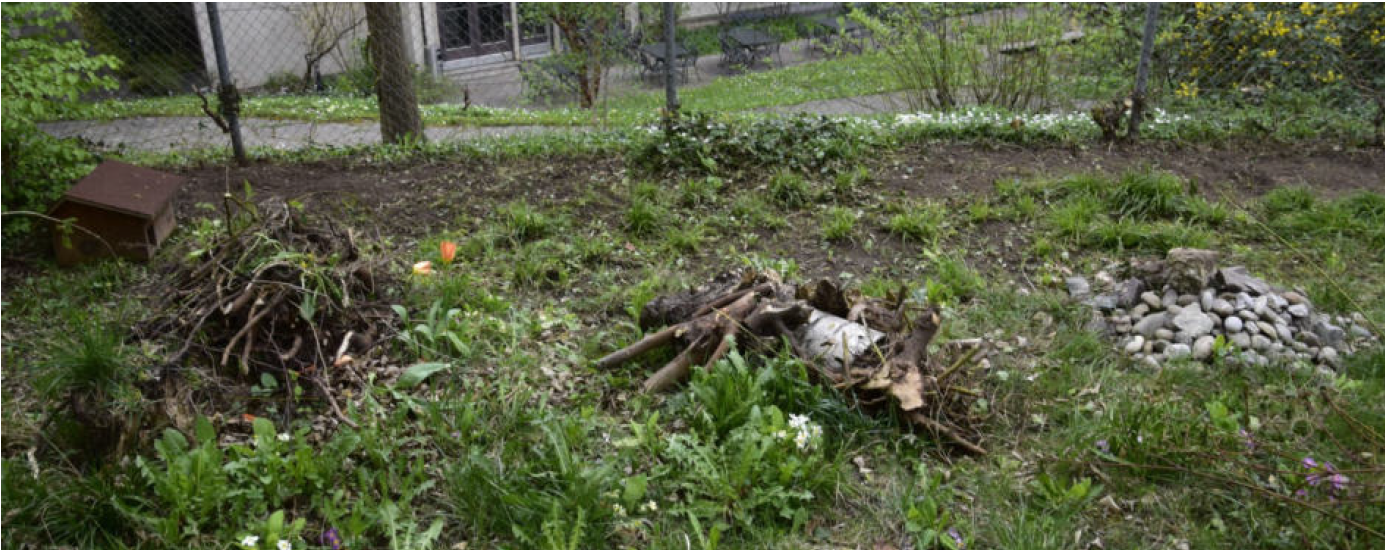 Pic 8 - Small structures: brushwood piles, deadwood piles, stone piles
Pic 8 - Small structures: brushwood piles, deadwood piles, stone piles
The remaining branches were processed into wood chips to create paths in the kitchen garden or to cover the unsealed car park. This not only promotes soil health and water permeability, but also prevents the growth of unwanted vegetation and reduces erosion. In addition, wood chip paths contribute to the aesthetic diversity of the garden, create clear paths and make the garden more pleasant and accessible for visitors. Overall, these practices support sustainable species management while promoting biodiversity within the garden.
4.3 More native than non-native shrubs
As the newly planted shrubs are still small and a lot of ivy has been removed, there are many open spaces between the shrubs. To protect the soil from drying out and erosion, underplanting with shrubs is planned in accordance with the ‘woodland edge GR2’ habitat. The Mainly native, shade-tolerant and flowering plants were selected. These provide new habitats for native fauna and prevent the spread of fast-growing plants. Various shrubs such as cypress spurge (Euphorbia cyparissias) and stinking hellebore (Helleborus foetidus, sowing) from their own garden have already been transplanted, and plants rescued at work, such as male fern (Dryopteris filix-mas), hart's tongue fern (Asplenum scolopendrium) and goat's beard (Aruncus dioicus), have been used in the new shrub planting.
4.4 More flowers than lawn and moss
Numerous primroses once bloomed in spring on a lawn measuring approximately 50 m². As part of an experiment to create a well-maintained lawn without pesky weeds, the lawn was intensively scarified and reseeded with ready-made seed mixtures, including fertiliser additives and seed aids. In the first few weeks, the new lawn developed as desired. However, due to a prolonged absence of the residents responsible for garden maintenance, the fresh lawn was not mowed and cared for sufficiently, which led to it becoming overgrown.
As a result, the lawn was only mowed with a hand cylinder mower when necessary, for example for barbecues or smaller events such as aperitifs and birthday parties. The entire area was never mowed, allowing a weed fringe to develop in the new shrub planting. The soil was also roughened several times and various meadow flower seed mixtures were sown to bring new life to the patchy, moss-covered lawn. However, these efforts have not yet led to satisfactory results, as apart from a few daisies and various types of grass, hardly any new plants have taken root. Possible reasons for this could be unsuitable site conditions, too many nutrients in the soil for the seed mixtures, or heavy feeding on the seedlings by snails during a wet spring.
Another attempt has now been made to upgrade the utility lawn into a more ecologically valuable flower lawn. To this end, the surface of the soil on various sections of the lawn was first roughened with a hand scarifier and moss was removed. The roughened soil was then covered in various places with different mineral mulch materials (crushed gravel 2/5, washed sand 0/4, crushed granite gravel 8/12, concrete gravel 0/16). The areas treated in this way were then sown with a site-appropriate, perennial wildflower mixture (Artha seeds wildflowers shady, 28 different species) and lightly worked into the mineral material. These measures are intended to simulate a depletion of the surface of the A horizon. The area of the lawn is now watered two to three times a week to keep the new seeds moist. Particular care is taken to ensure that watering is even, in order to guarantee uniform germination and establishment of the wildflowers. In addition, regular checks are carried out to identify potential problems such as pest infestation or competition from unwanted grasses and weeds at an early stage and to take appropriate action.
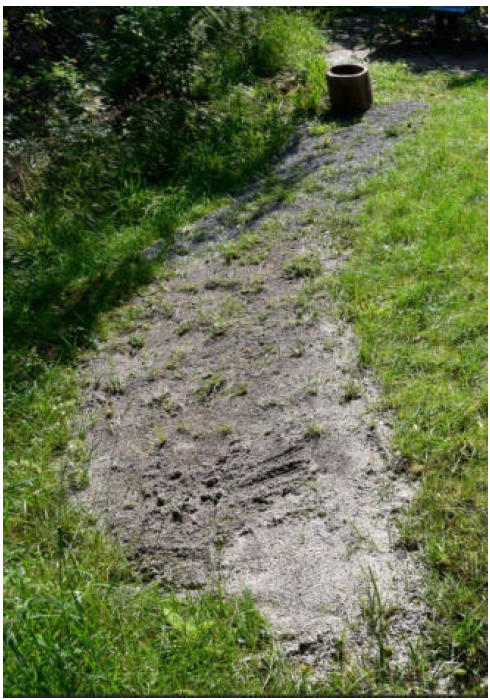 Pic 9 - Experiment on weight loss with mulch materials sand and grit
Pic 9 - Experiment on weight loss with mulch materials sand and grit
To ensure the long-term success of the conversion to a species-rich habitat, a maintenance plan is being drawn up which, in addition to irrigation, also provides for the selective removal of highly competitive plants. This includes mowing once a year, but not leaving the clippings on the ground in order to minimise nutrient input. The gradual introduction of additional wildflower seeds is also planned in order to further increase biodiversity and extend the flowering period.
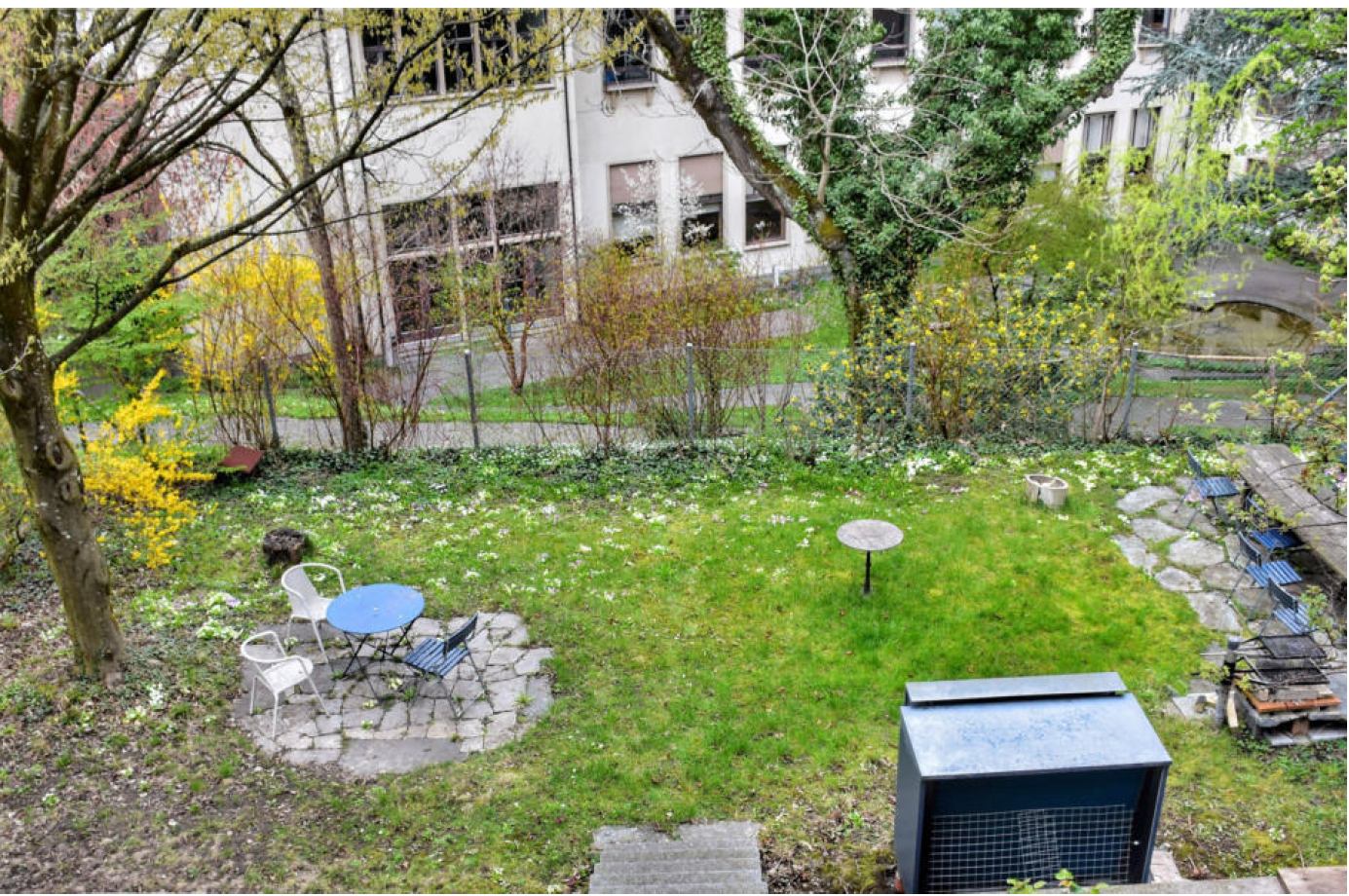 Pic 10 - View of the rear section of the garden on Affolternstrasse before any work was carried out
Pic 10 - View of the rear section of the garden on Affolternstrasse before any work was carried out
Pictures
(Pic 7) - Lukas Bachofner, April 2025 (Pic 8) - Lukas Bachofner, April 2025 (Pic 9) - Lukas Bachofner, April 2025 (Pic 10) - Lukas Bachofner, March 2021
Table
(Tab 4) - Lukas Bachofner, Microsoft Office Word and Power point, April 2025
I wrote the paper myself and translated it from German using deepl.com. The images and the text in German were created without AI.
AUTHOR/PHOTOGRAPHER : Lukas Bachofner INSTAGRAM : lukasbachofnerfoto
HISTORY
A project on biodiversity in urban areas Part 1
| KAMERA | Nikon | D5600 |
|---|---|---|
| LENS | AF-S Nikkor | 18-140mm |
| DX VR 1:35-56 GED | ||
| AF-S Nikkor | 55-300mm | |
| DX VR 1:4.5-5.6 GED | ||
| SMARTPHONE | Xiaomi | Note 10 Pro |
| PICTURE EDITING | Snapseed | Android App |

🔥🔥🔥🔥🔥
Check out my once daily series of a photographical post/shot...
ONLY ONE - Only one photo, a moment, a history, a perspective. How I see the world.
Once daily Posts but only one picture but one to marvel at and dream about
🔥🔥🔥🔥🔥
Check out my series of a architecturally dizzying posts/shots...
ARCHITECTURE IN A SQUARE
🔥🔥🔥🔥🔥